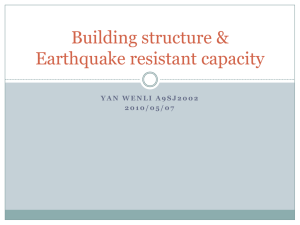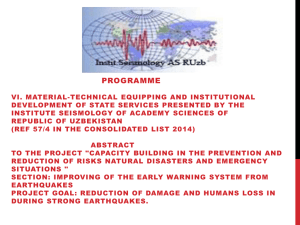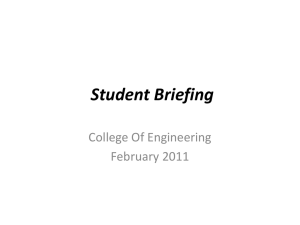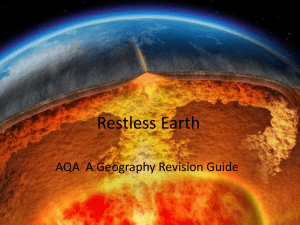Hazard based training- Earthquakes
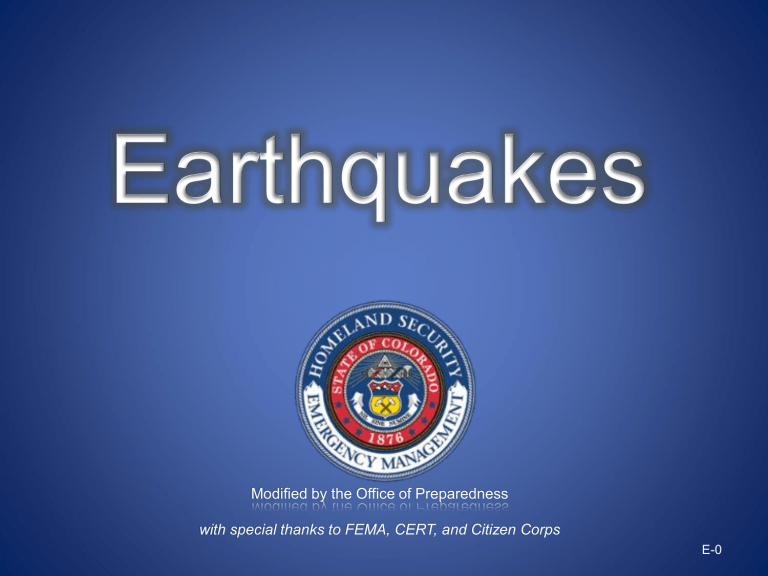
Earthquakes
Modified by the Office of Preparedness with special thanks to FEMA, CERT, and Citizen Corps
E-0
An Earthquake is…
• The sudden slipping or movement of portions of the Earth ’ s crust against one another
– Caused by a sudden release of stresses
– Usually less than 25 miles below the surface
E-1
Earthquake Terms to Know
Part 1
Aftershocks: These are earthquakes which follow the largest shock. They can continue for weeks, months and even years
Epicenter: The point on the Earth ’s surface above the point deep in the Earth ’s crust where an earthquake occurs
E-2
Earthquake Terms to Know
Part 2
Fault: A fracture or crack along which two blocks of rock slide past each other
Magnitude: The amount of energy released at the epicenter by the earthquake – measured using various scales (ex. Richter scale)
E-3
Richter Scale
• Small: 5.0 to 5.9
• Moderate: 6.0 to 6.9
• Major: 7.0 to 7.9
• Great: 8.0 or greater
E-4
Earthquake Terms to Know
Part 3
Seismologists: Scientists who study earthquakes, their causes, and effects
Seismographs: Instruments that make an automatic record of the time, duration, direction, and intensity of earthquakes.
E-5
Earthquake Damage
• Collapsed buildings
• Damage to utilities, structures, and roads
• Fires and explosions
• Structural instability, e.g., dams
• Landslides and debris flows
E-6
Likelihood of an Earthquake
• Greatest likelihood
– Western United States
‒ San Andreas Fault
‒ Western Oregon and Washington
‒ Alaskan coast
– New Madrid Fault Zone in Missouri
– Few pockets on East Coast
‒ Coastal South Carolina
‒ New England
E-7
Earthquake Statistics
• 75 million Americans in 39 states face significant risk
• Residents of California face the highest risk (17 million people) followed by residents of western Washington State
E-8
Likelihood of an Earthquake in Colorado
• Colorado has less earthquake activity than states like California but is still susceptible
• We have had over 400 magnitude 2.5 or higher earthquakes since 1867
• The largest earthquake experienced here was estimated at magnitude 6.6 in 1882 in
North-Central CO
E-9
Trinidad Earthquake - 2011
E-10
Earthquake Preparedness
Step 1: Secure it
Secure your space -
• Store and secure heavy or breakable objects on low shelves
• Secure bookshelves and water heaters
• Move beds away from windows
E-11
Earthquake Preparedness
Step 1: Secure it Cont.
Secure your space -
• Secure heavy pieces of unstable furniture to the ground or walls
• Move or secure hanging objects over beds, sofas, or chairs
• Put latches on cabinet doors
E-12
Earthquake Preparedness
Step 2: Make a plan
• Develop home earthquake plan
– Think about safe places in your home, school and/or work
• Conduct earthquake drills
• Develop plan for reuniting family members
• Develop family communication plan
• Keep supplies on hand
E-13
Earthquake Preparedness
Step 3: Make a checklist or
3 day kit
- Create an emergency kit, which includes enough supplies for each member of your family, including:
- Food
- Water
- Clothing,
- Flashlights
- First aid kits
E-14
Earthquake Preparedness
Step 3: Make a checklist or
3 day kit
- Other items you may want to include are
- NOAA weather radio
- Extra batteries
- Whistle
- Dust masks
- Personal sanitary items
- Maps
- Eating utensils
E-15
Earthquake Preparedness
Step 3: Make a checklist or
3 day kit
Check out readycolorado.com for more help making a kit or creating a checklist specific to your family, including pets!
E-16
Earthquake Preparedness
Step 4: Make your home safer
- Check for vulnerable pipes, and install flexible pipes where possible
- Check your home ’s foundation
- Fix unreinforced masonry
E-17
During an Earthquake
Step 5: Drop, Cover and Hold on!
DROP
Drop down to the Floor
E-18
During an Earthquake
Step 5: Drop, Cover and Hold on!
COVER
Take cover by getting under a sturdy desk, table or other stable piece of furniture. If this is not possible, cover your head and neck with your arms and crouch in an inside corner of a building or against an interior wall.
E-19
During an Earthquake
Step 5: Drop, Cover and Hold on!
HOLD
Hold on and stay in that position until the shaking stops and it is safe to move.
E-20
During an Earthquake
Step 5: Drop, Cover and Hold on!
• If you are outdoors , find a spot away from buildings, trees, streetlights, power lines, and overpasses
• If you are on the sidewalk near a building, duck under a doorway to protect yourself from falling debris
• If you are in a vehicle , drive to clear spot and stop
– Stay in the vehicle until shaking is over
E-21
During an Earthquake
Step 5: Drop, Cover and Hold on!
• If you are in a stadium stay in your seat, crouch down, and protect your head and neck
• If you are in a crowded store or other public space move away from display shelves. Do not rush for the exit!
• If you are in a tall building, move against an interior wall and protect your head and neck. Do not use elevators!
E-22
Recovering from an earthquake
Step 6: Check it out
– Check yourself for injuries and protect yourself from further danger before helping others
• Consider becoming certified in First Aid, and
CPD/AED before a disaster happens
• Identify hazards such as damaged gas, water, sewage, and electrical lines – stay away from these!
– Prepare yourself for possible aftershocks
– Begin following your disaster preparedness plan
E-23
Recovering from an earthquake
Step 6: Check it out
If you are trapped under debris –
-Do not light a match
-Cover your mouth with a handkerchief or clothing
-Avoid kicking up dust
-Tap on a pipe or wall so rescuers can find you or use a whistle if available
- Try not to should unless it is a last resort, in order to avoid breathing in large amounts of dust
E-24
Recovering from an earthquake
Step 7: Communicate and
Recover
– Tune to Emergency Alert System (EAS) through a radio to keep up to date with updates and safety information
– Notify an out of area contact, then stay off the phone. Text only.
– Help neighbors
– Wear shoes to protect yourself from glass and other sharp objects
– Be ready for possible aftershocks
E-25
Recovering from an earthquake
Step 7: Communicate and
Recover
Inspect home for damage if there are no immediate hazards are present
• Check appliances for damage
• Switch off electrical power if there is damage to electrical wiring
• Check gas lines for damage, turn off the main gas valve outside if a gas leak is suspected
• Check the building for cracks and other damage
• Check to see that water and sewage lines are intact
• Check water and food supplies
• Check closets and cupboards (be careful, items have likely shifted)
E-26
Recovering from an earthquake
Step 7: Communicate and
Recover Cont.
– Extinguish small fires
– Clean up spills
– Do not use your car unless absolutely necessary, or until you are given the ok by responders
E-27
Questions
E-28




